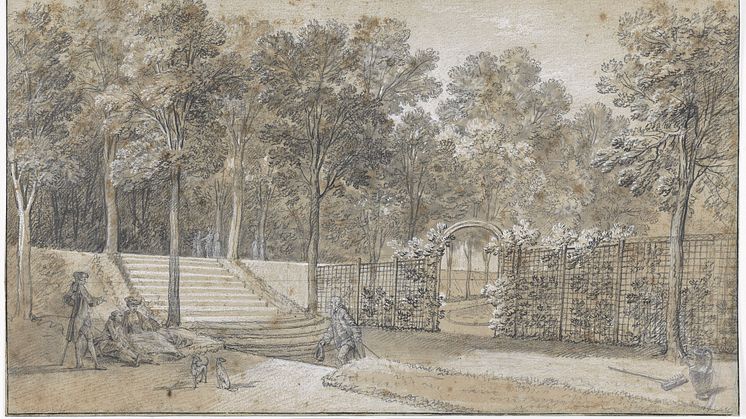
Press release -
New Acquisition: Jean Baptiste Oudry's Views from Arcueil
Nationalmuseum has acquired two drawings with views from the garden and park of Arcueil by the French Rococo master Jean-Baptiste Oudry. The drawings depict a geometrically landscaped garden with elements of a freer park in a state of picturesque decay. The artist presents both immediate visual impressions and more artfully elaborated ones. This type of landscape had previously been completely lacking from the museum's large collection of works by Oudry.
Jean-Baptiste Oudry (1686–1755) has become known as one of the foremost artists of the French Rococo style. He began as a portrait painter but soon came to specialise in still life painting. His close friends and clients included the Swede Carl Gustaf Tessin, which is also why Nationalmuseum has so many works by the artist in its collection. Oudry’s activities as a landscape painter are somewhat less known. At times, he is even said to have used a camera obscura in the production of his views.
Starting in 1740, Oudry began to make excursions to scenic Arcueil, located in the southern suburbs of Paris. The place was famous for its beautiful garden and park, which boasted a monumental aqueduct as a backdrop. Today, most of it has vanished or been rendered unrecognisable. The garden complex, which attracted artists such as Oudry, Boucher and Natoire, was created for the Prince of Guise between 1720 and 1730 by the architect Jean-Michel Chevotet. Among Chevotet's fellow students at the French Academy of Architecture was the Swede Carl Hårleman, and both specialised in landscape architecture. Arcueil was transformed into an intimate formal garden in the spirit of Rococo, with geometric elements such as parterres, ponds and trellis works. The differences in terrain levels on the site created movement and vistas. It was thus also necessary to construct a variety of walls, terraces and stairs, which contributed to the special and complex character of the garden. There was also a wilder and more informal section with a picturesque touch.
It is therefore hardly surprising that Oudry was fascinated by Arcueil. He rented a house that was located directly adjacent to the property, which gave him many opportunities to draw various views. Most are believed to have been executed between 1744 and 1747. Many have an immediate character, revealing that they were drawn outdoors, on site. Others appear more elaborate. Over fifty such views are known to exist, two of which have now been acquired by Nationalmuseum. Of them, the view to the north with the orangery terrace and the peak of the forest park (or so-called ‘talus cone’), is among Oudry's finest drawings from Arcueil. The artist has worked on a beige paper (which was probably originally blue) with black and white chalk, which he then smudged with a stump (an artist’s tool made of hard rolled paper or chamois leather). Then Oudry used a brush to add highlights in white gouache. In this way he managed to create fine contrasts between sunlit areas and other shady parts of the image. The figures are considered to have been drawn by another hand, perhaps Victoire Chenu or Jacques-Philippe Le Bas, who later (1776) engraved and published this view under the title Ancienne et première vue d'Arcueil.
While the view from the orangery terrace has the character of a completed drawing, or what Carl Gustaf Tessin called la manière très finie, Oudry's second drawing is characterised by a seemingly immediate visual sensibility. It was create using chalk and faint white gouache highlights on a grey-blue paper, and reproduces a more informal part of the garden, a bosquet area with a promenade. In the background one can see a garden shed with a somewhat dilapidated fence. In this view, Oudry has depicted a pastoral scene which seems quite distant from the more formal environment of the previous drawing and thus appears to herald the parks of the late 18th century.
Nationalmuseum receives no state funding with which to acquire design, applied art and artwork; instead the collections are enriched through donations and gifts from private foundations and funds. The acquisitions have been made possible through a purchase using donations from the Wiros Foundation and the Hedda and Nils D. Qvist Memorial Fund.
Inventory number:
Jean-Baptiste Oudry, View of the Garden in Arcueil, Facing North with the Orangery Terrace and the Peak of the Forest Park or So-Called ‘Talus Cone’, 1744–1747. NMH 55/2019.
Jean-Baptiste Oudry, View of the Bosquet in the Garden of Arcueil with Promenade and Garden Shed, 1744–1747. NMH 46/2018.
For further information
Magnus Olausson, Head of Collections, magnus.olausson@nationalmuseum.se +46 (0)8 5195 4371
Hanna Tottmar, Head of Press, press@nationalmuseum.se, +46 (0)8 5195 4400
Categories
Nationalmuseum is Sweden’s museum of art and design. The collections include paintings, sculpture, drawings and graphic art from the 16th century up to the beginning of the 20th century and the collection of applied art and design up to the present day. The museum building closed for renovation in 2013 and reopened in autumn 2018. During 2019 the museum had almost 850 000 visits.

